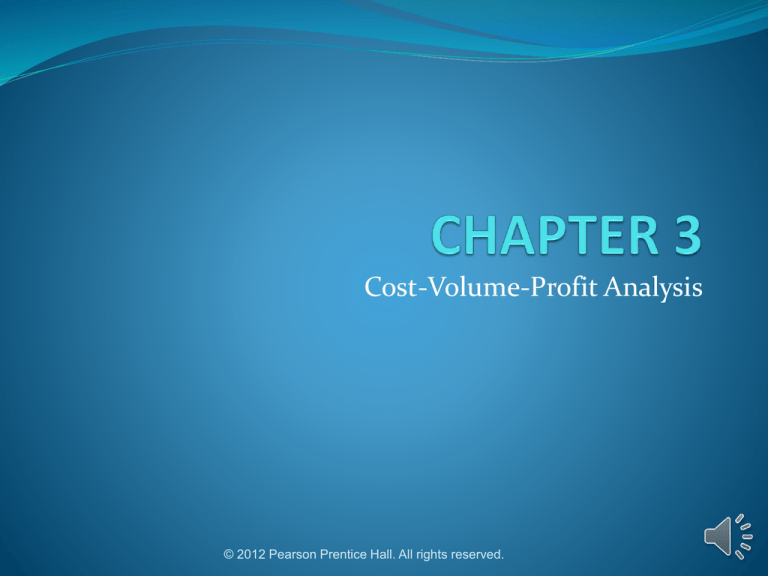
Cost-Volume-Profit Analysis
© 2012 Pearson Prentice Hall. All rights reserved.
Foundational Assumptions in CVP
Changes in production/sales volume are the sole cause
for cost and revenue changes.
Total costs consist only of fixed and variable costs.
Revenue and costs behave as a linear function (a
straight line).
Selling price, variable cost per unit, and fixed costs are
all known and constant.
If multiple products are sold, their relative sales
proportions (sales mix) are known and constant.
© 2012 Pearson Prentice Hall. All rights reserved.
Basic Formulae
© 2012 Pearson Prentice Hall. All rights reserved.
CVP: Contribution Margin
Manipulation of the basic equations yields an
extremely important and powerful tool extensively
used in cost accounting: contribution margin (CM).
Contribution margin = revenue less variable cost.
Contribution margin per unit equals unit selling price
less unit variable costs. For a particular item, assume
Unit Price
Unit VC
Unit CM
$2.50
1.75
$ .75
100%
70% (VC%)
30% (CM%)
© 2012 Pearson Prentice Hall. All rights reserved.
Breakeven Point
At the breakeven point, a firm has no profit or loss at
the given sales level.
Sales – Variable Costs – Fixed Costs = 0
Calculation of breakeven number of units
Breakeven Units =
Fixed Costs_
_
Contribution Margin per Unit
Calculation of breakeven revenues
Breakeven Revenue =
Fixed Costs_
_
Contribution Margin Percentage
© 2012 Pearson Prentice Hall. All rights reserved.
Breakeven Point, extended:
Profit Planning
The breakeven point formula can be modified to
become a profit planning tool.
Profit is now added to the BE formula, changing it to a
simple sales volume equation.
Quantity of Units = (Fixed Costs + Operating Income)
Required to Be Sold
Contribution Margin per Unit
© 2012 Pearson Prentice Hall. All rights reserved.
CVP: Graphically
© 2012 Pearson Prentice Hall. All rights reserved.
Profit Planning, Illustrated (p. 74)
© 2012 Pearson Prentice Hall. All rights reserved.
CVP and Income Taxes
After-tax profit can be calculated by:
Net Income = Operating Income * (1-Tax Rate)
Net income can be converted to operating income for
use in CVP equation
Operating Income
= II
Net Income
(1-Tax Rate)
© 2012 Pearson Prentice Hall. All rights reserved.
I
Sensitivity Analysis
CVP provides structure to answer a variety of “what-
if” scenarios.
“What” happens to profit “if”:
Selling price changes.
Volume changes.
Cost structure changes.
Variable cost per unit changes.
Fixed cost changes.
© 2012 Pearson Prentice Hall. All rights reserved.
Margin of Safety
One indicator of risk, the margin of safety (MOS),
measures the distance between budgeted sales and
breakeven sales:
MOS = Budgeted Sales – BE Sales
The MOS ratio removes the firm’s size from the
output, and expresses itself in the form of a
percentage:
MOS Ratio = MOS ÷ Budgeted Sales
© 2012 Pearson Prentice Hall. All rights reserved.
Operating Leverage
Results from having fixed costs
© 2012 Pearson Prentice Hall. All rights reserved.
Operating Leverage
Operating leverage (OL) is the effect that fixed costs
have on changes in operating income as changes occur
in units sold, expressed as changes in contribution
margin.
OL = Contribution Margin
Operating Income
Notice these two items are identical except for fixed
costs: Operating Income = CM-FC
© 2012 Pearson Prentice Hall. All rights reserved.
Effects of Sales-Mix on CVP
To this point we have assumed a single product is
produced and sold.
A more realistic scenario involves multiple products
sold, in different volumes, with different costs.
The same formulae are used, but instead use average
contribution margins for “bundles” of products.
© 2012 Pearson Prentice Hall. All rights reserved.
[Remaining slides added by CB]
Decision Models and Uncertainty
Managers frequently must deal with uncertainty.
The model presented here represents a rational
approach to decision making under uncertainty,
assuming you are risk-neutral.
© 2012 Pearson Prentice Hall. All rights reserved.
Risk attitudes
Are you risk-averse?
Would you toss a coin for $20?
Would you prefer $100 with .50 probability or $48
certain?
Managers tend to be risk-averse in general
But will become risk-seeking when in a loss situation
“Prospect theory” of Tversky & Khaneman
Compare gamblers in a casino, etc.
© 2012 Pearson Prentice Hall. All rights reserved.
Decision Model Assumptions
Choice Criterion
Set of Alternatives (Actions to consider)
Mutually exclusive, Exhaustive
Set of Events (States of Nature)
Set of Probabilities associated with the events
Set of Outcomes (Income, cost, etc., to minimize or
maximize)
© 2012 Pearson Prentice Hall. All rights reserved.
Example of DM under Uncertainty
Action Taken
Buy new Eqpt.
E
v
e
n
t
Keep old Eqpt.
Get Govt
Contract
Income =
$500,000
Income =
$300,000
Not get Govt
Contract
Income =
$10,000
Income =
$200,000
Which action is best?
Depends on probabilities we assign to the events.
© 2012 Pearson Prentice Hall. All rights reserved.
Decision Models and Uncertainty
EV=Σ (Outcomei) (Pi)
i.e., summation of each outcome (in this case, income)
times the probability of that outcome.
Suppose P(getting contract) = .20
[read as “probability of getting contract = .20”]
Thus P(not getting contract) = .80.
EV(buying new Eqpt) = $500,000*.20 + $10,000*.80 = $108,000
EV(keeping old Eqpt) = $300,000*.20 + $200,000*.80 = $220,000
To maximize expected value, we keep old equipment.
© 2012 Pearson Prentice Hall. All rights reserved.
Good decision vs. good outcome
You take your life savings (assume $100,000) and put it
all on a roulette wheel spin “straight up bet” (any
single number). You win and claim $3,500,000!
Was it a good decision?
Was it a rational decision?
A “good” decision is one made on the information
available at the time, applying one’s values in a rational
way. (Hindsight bias is huge, though!)
Luck (things outside your control) plays a much bigger
part in business and life than you think!
© 2012 Pearson Prentice Hall. All rights reserved.








